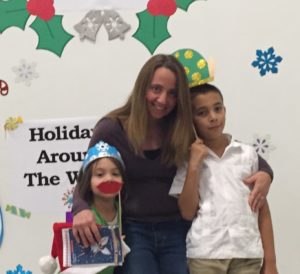
Danielle Miller lives, works and plays in San Antonio, Texas. When not attempting to instill a love of reading and writing to middle school students, she enjoys spending time with her family and friends: swimming to beat the heat, reading together, enjoying the natural world inside and outside of the city, and learning new things together.
I am a teacher. Not only am I a teacher, but I am a teacher of 7th graders (I know, right?).
I headed back to school this fall to prepare for a new year with these students who I know are clearly not adults, but who inform me, in no uncertain terms, that they are not children either.
I teach on the eastside of San Antonio. It is a community with extreme poverty, violence and a high dropout rate. And it is a community in which I simply don’t very easily fit. I’m white. Ninety-nine percent of this community are not. I come from financial and emotional stability. Many of them do not. My colleagues in the English Language Arts department love to use an app to make music videos, and when they do, I spend more effort trying to hide than anything that might resemble dancing.
dropout rate. And it is a community in which I simply don’t very easily fit. I’m white. Ninety-nine percent of this community are not. I come from financial and emotional stability. Many of them do not. My colleagues in the English Language Arts department love to use an app to make music videos, and when they do, I spend more effort trying to hide than anything that might resemble dancing.
So when my students Angela and Kristal burst into class at the last possible second dancing and laughing at a decibel likely to cause hearing damage, my instinct is to step into the traditional role of teacher and define what is right and wrong. What is good and bad. Translation: I can identify what is comfortable for me. I can identify the culture and climate that allows me to learn. One that I connect to. One that makes sense in my world.
There is only one girl in the 7th grade who looks even remotely like what I looked like in 7th grade. And honestly, she is a joy to work with. She sits quietly and listens. She reads well and writes well. And she wants to learn.
But Angela wants to learn too. The problem is that there are a lot of things that get in the way. She has never known her dad, her mom is in jail and her aunt is raising her. But her aunt spends more time wishing Angela was like her own son and reminding her that she is a failure — even though she is brilliant. This compels Angela to push every limit she encounters, doing whatever she wants to do and squeaking by with a 70 every reporting period while missing only two questions on her state assessment reading test. So how do I teach Angela when she, in no way, resembles me, and on a daily basis interferes with what I have tried to define as a successful classroom? It is the challenge I face every day when I walk into school. It is why I spent my summer reading literature and rewriting the curriculum to attempt to not reflect my face, but the faces and hearts (and crazy middle school brains) of my students.
Mother Teresa spoke of seeing Christ “in the disguise of the poor.”
It is my challenge to create the space to welcome Christ into my room in all forms and moods and attitudes of eastside San Antonio middle school students and to be open to their truth and wisdom.
This is what being called to put love into action means to me. It is facing the discomfort of these truth tellers and allowing them to help me recognize my own prejudices, judgments and weaknesses. There are too many days that I say — who are you to come into my classroom and tell me that what I know to be Truth is not necessarily the whole Truth?
Loving means to be truly open to identifying and welcoming Jesus’ true self — not the Jesus who looks like us, but the Jesus who has called us to leave our comfort zones and truly do the work of loving our neighbors and all strangers as ourselves.


